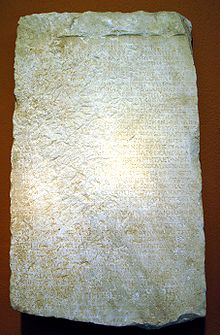- Decree of Themistocles
-
Decree of Themistocles, National Archaeological Museum of Athens, 13330

The Decree of Themistocles is an ancient Greek inscription discussing Greek strategy in the Greco-Persian Wars, purported to have been issued by the Athenian assembly under the guidance of Themistocles. Since the publication of its contents in 1960, the authenticity of the decree has been the subject of much academic debate. The decree directly contradicts Herodotus's account of the evacuation of Attica in 480 BC, in which it is stated that the evacuation was an emergency measure taken only after the Peloponnesian army failed to advance into Boeotia to fight the Persians. If the decree is authentic, the abandonment of Attica was part of a considered strategy aiming to draw the Persians into naval combat at Artemisium or Salamis.
Contents
Discovery
The stone bearing the Themistocles decree (Epigraphical Museum, Athens, EM 13330)[1]was discovered at some point before 1959 by a farmer at Troezen, in the northwestern Peloponnese. For some time, he used the inscribed marble slab as a doorstep. In 1959, he donated the stone to a collection of artifacts from Troezen that a local schoolteacher was displaying at a coffeehouse. There, Professor M.H. Jameson of the University of Pennsylvania saw the slab, and, the next year, published its contents along with a translation and commentary.[2]
Contents
The inscription begins with a statement that the contents are a resolution of the Athenian assembly, proposed by Themistocles. It then lays out a plan to evacuate the women, children, and elderly of Attica to Troezen and Salamis, while the men board triremes and prepare to defend the city, leaving only the treasurers and priestesses on the acropolis. The majority of the extant text then turns to the specifics of preparing the fleet, with the text on the slab becoming illegible before the end of the decree.[3]
Significance
If the account of the evacuation of Athens implied by the Themistocles decree is accurate, the Herodotean account of the events of 480 BC must be revised to reflect a Greek strategy, agreed on in June, focused on stopping the Persian advance at Salamis and the Isthmus of Corinth. If this was indeed the Greek plan, then Thermopylae and Artemisium, which Herodotus describes as all-out attempts to defeat the Persian invasion, would in fact have been only holding actions intended to give time for the evacuation of Attica and the preparation of the defenses of the isthmus.[4]
Academic controversy
Challenging as it did the Herodotean account that had up to that point stood as the definitive account of the Greco-Persian Wars, the authenticity of the Themistocles decree soon became the subject of heated scholarly debate. A study of the letter forms used suggested that the marble slab on which the decree was inscribed had been carved in the first half of the 3rd century BC, raising the question of how the text had survived for two centuries, particularly given that Athens was sacked by the Persians in 480 and again in 479 BC.[5] The first extant mention of a decree that can be identified with the one found at Troezen comes from Demosthenes, who records that Aeschines read the decree aloud in 347 BC, again leaving a gap of over a century to account for.[6] Scholars who support the authenticity of the decree point to the last two lines of the famous oracle given to the Athenians:
Divine Salamis, you will bring death to women's sons
When the corn is scattered, or the harvest gathered in.[7]The identification of Salamis as the site of slaughter would seem to suggest that a strategy calling for a battle there had already been agreed upon by the Greek commanders, which would indicate that the account supported by the Themistocles decree is correct.[4] Scholars skeptical of the decree however raise a number of arguments against its authenticity. The correlation provided by the oracle's mention of Salamis has been challenged by pointing out that oracles were sometimes altered after the fact;[4] various anachronisms in phrasing have been pointed out, although supporters of the text's authenticity dismiss these, noting that Greek practice was to paraphrase documents rather than copy them verbatim;[8] finally, more serious content issues, ranging from chronologically suspect passages to statements that seem out of place in an official decree to serious conflicts with Herodotus's detailed descriptions of Greek troop dispositions.[9] In light of these objections, John Fine has argued that it is best to treat the Themistocles decree, if authentic, as an amalgamation of several decrees released at different times.[10]
References
- Fine, John V.A. The Ancient Greeks: A critical history (Harvard University Press, 1983) ISBN 0-674-03314-0
- Herodotus, Histories
Notes
- ^ Photo from Epigraphical Museum's website
See also Epigraphical Museum - ^ Original publication: Jameson, M. "A Decree of Themistocles from Troizen." Hesperia 29 (1960): 198-223. See also Fine, The Ancient Greeks, 305.
- ^ The text of the decree, and other relevant ancient texts, may be found at [1].
- ^ a b c Fine, The Ancient Greeks, 308
- ^ Fine, The Ancient Greeks, 306-7
- ^ Fine, The Ancient Greeks, 307
- ^ Herodotus, Histories 7.141
- ^ Fine, The Ancient Greeks, 309
- ^ Fine, The Ancient Greeks, 310-11
- ^ Fine, The Ancient Greeks, 311
Categories:- Classical Athens
- Greek inscriptions
- Greco-Persian Wars
Wikimedia Foundation. 2010.

